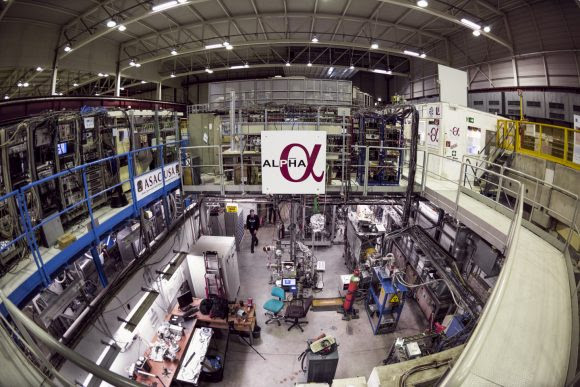Ever since the existence of antimatter was proposed in the early 20th century, scientists have sought to understand how relates to normal matter, and why there is an apparent imbalance between the two in the Universe. To do this, particle physics research in the past few decades has focused on the anti-particle of the most elementary and abundant atom in the Universe - the antihydrogen particle.
Until recently, this has been very difficult, as scientists have been able to produce antihydrogen, but unable to study it for long before it annihilated. But according to recent a study that was published in Nature, a team using the ALPHA experiment was able to obtain the first spectral information on antihydrogen. This achievement, which was 20 years in the making, could open up an entirely new era of research into antimatter.
Measuring how elements absorb or emit light - i.e. spectroscopy - is a major aspect of physics, chemistry and astronomy. Not only does it allow scientists to characterize atoms and molecules, it allows astrophysicists to determine the composition of distant stars by analyzing the spectrum of the light they emit.

The ALPHA experiment probes whether matter behaves differently from antimatter by measuring the antihydrogen spectrum with high-precision, further testing the robustness of the Standard Model. Credit: Maximilien Brice/CERN
In the past, many studies have been conducted into the spectrum of hydrogen, which constitutes roughly 75% of all baryonic mass in the Universe. These have played a vital role in our understanding of matter, energy, and the evolution of multiple scientific disciplines. But until recently, studying the spectrum of its anti-particle has been incredibly difficult.
For starters, it requires that the particles that constitute antihydrogen - antiprotons and positrons (anti-electrons) - be captured and cooled so that they may come together. In addition, it is then necessary to maintain these particles long enough to observe their behavior, before they inevitable make contact with normal matter and annihilate.
Luckily, technology has progressed in the past few decades to the point where research into antimatter is now possible, thus affording scientists the opportunity to deduce whether the physics behind antimatter are consistent with the Standard Model or go beyond it. As the CERN research team - which was led by Dr. Ahmadi of the Department of Physics at the University of Liverpool - indicated in their study:
ALPHA uses a magnetic trap to hold neutral atoms of antihydrogen and then subjecting them to spectrographic analysis. Credit: CERN
Beginning in 1996, this research was conducted using the AnTiHydrogEN Apparatus (ATHENA) experiment, a part of the CERN Antiproton Decelerator facility. This experiment was responsible for capturing antiprotons and positrons, then cooling them to the point where they can combine to form anithydrogen. Since 2005, this task has become the responsibility of ATHENA's successor, the ALPHA experiment.
Using updated instruments, ALPHA captures atoms of neutral antihydrogen and holds them for a longer period before they inevitably annihilate During this time, research teams conduct spectrographic analysis using ALPHA's ultraviolet laser to see if the atoms obey the same laws as hydrogen atoms. As Jeffrey Hangst, the spokesperson of the ALPHA collaboration, explained in a CERN update:
In so doing, the research team was able to measure the frequency of light needed to cause a positron to transition from its lowest energy level to the next. What they found was that (within experimental limits) there was no difference between the antihydrogen spectral data and that of hydrogen. These results are an experimental first, as they are the first spectral observations ever made of an antihydrogen atom.
Besides allowing for comparisons between matter and antimatter for the first time, these results show that antimatter's behavior - vis a vis its spectrographic characteristics - are consistent with the Standard Model. Specifically, they are consistent with what is known as Charge-Parity-Time (CPT) symmetry.
This symmetry theory, which is fundamental to established physics, predicts that energy levels in matter and antimatter would be the same. As the team explained in their study:
In other words, the confirmation that matter and antimatter have similar spectral characteristics is yet another indication that the Standard Model holds up - just as the discovery of the Higgs Boson in 2012 did. It also demonstrated the effectiveness of the ALPHA experiment at trapping antimatter particles, which will have benefits other antihydrogen experiments.
Naturally, the CERN researchers were very excited by this find, and it is expected to have drastic implications. Beyond offering a new means of testing the Standard Model, it is also expected to go a long way towards helping scientists to understand why there is a matter-antimatter imbalance in the Universe. Yet another crucial step in discovering exactly how the Universe as we know it came to be.
Further Reading: CERN
|
Tuesday, December 20, 2016
Spectrum of Antimatter Observed for First Time
Subscribe to:
Post Comments (Atom)
ENERGY NEWS
Oil prices rally on geopolitical tensions April 10 (UPI) -- Geopolitical factors spilled over into the broader economic mood early ...
-
SpaceX Postpones Falcon 9 Rocket Launch Resumption to January 2017 Ken Kremer द्वारा SpaceX Falcon 9 Stage 1 arriving in Califo...
-
© Masao et al. / ELife 2016 MOSCOW, December 14 - RIA Novosti . Scientists have found traces in Tanzania unusually l...
-
06-Apr-2017 Honey Bees Have Sharper Eyesight Than We Thought Research conducted at the University of Adelaide has discovered that be...
-
LMRC Recruitment 2017 lmrcl.com Vacancy Latest Notification Apply ALIMCO Recruitment 2017 alimco.in Various Posts 55 Openings App...
-
Bob King द्वारा Striations exposed on the surface between Martian sand dunes (one pictured at top) in Lucaya Crater indicate fl...

No comments:
Post a Comment